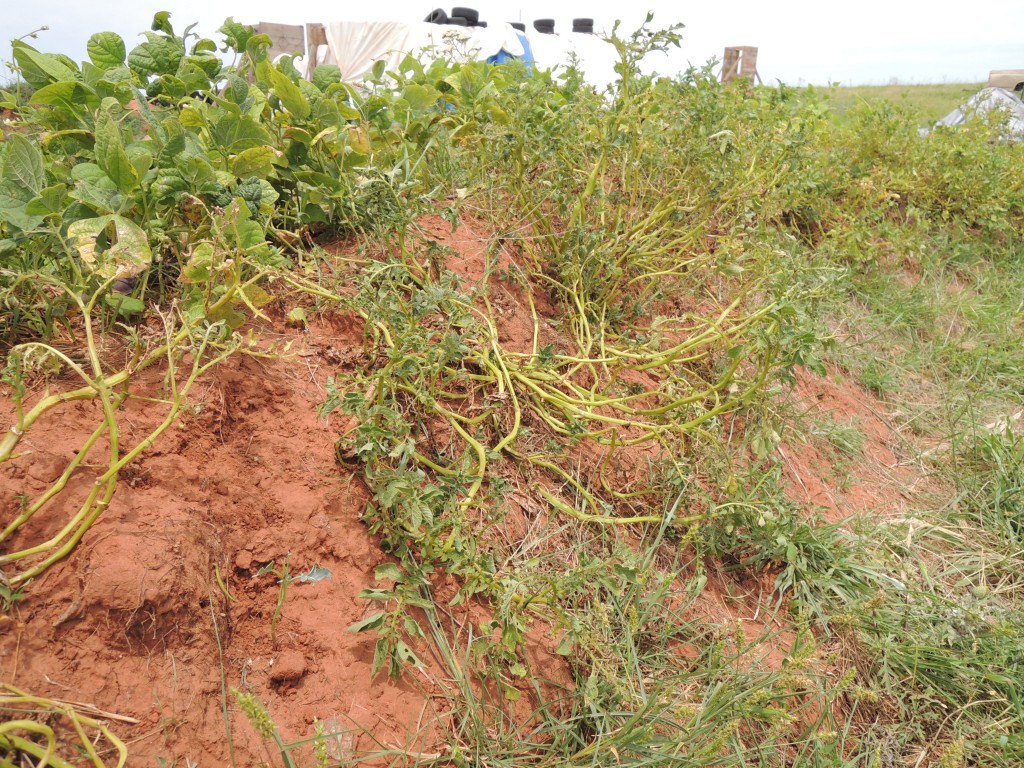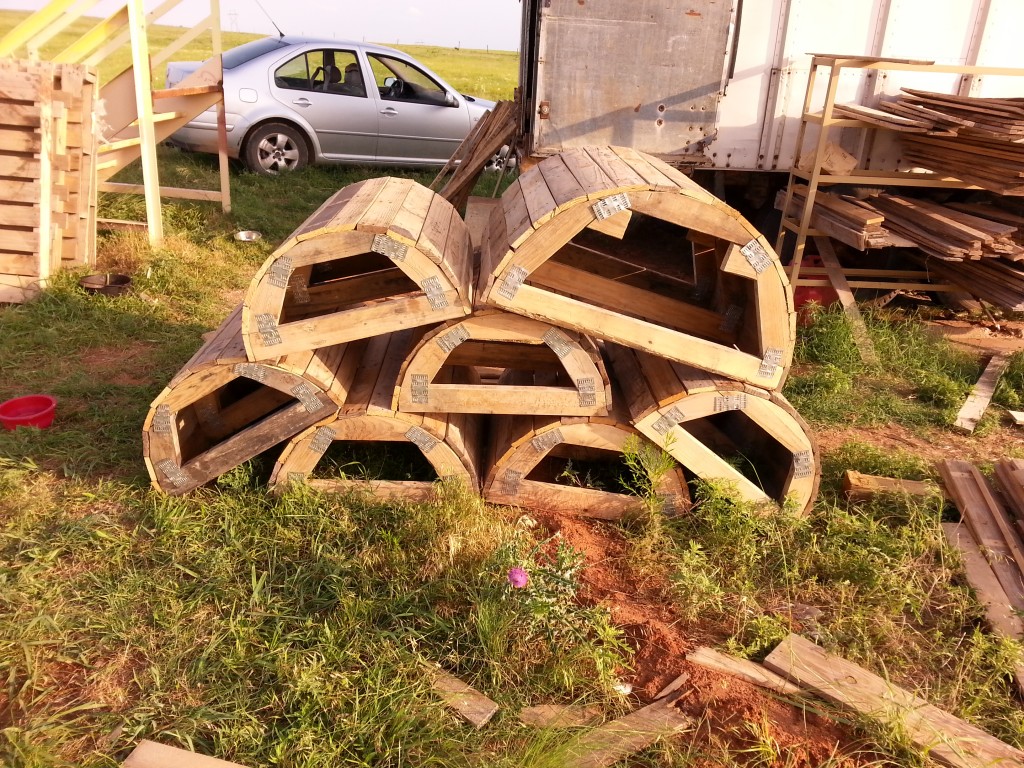June is my second favorite month in Oklahoma. Our second son was born on the 5th. You can read about our Home Birth Story if you haven’t already. The day of his birth was almost a record heat day at 95 degrees. It was 96 degrees on that day in 1977. The other 29 days weren’t near as sweltering. There were a surprising number of rainy and overcast days. We got almost 5 inches of rain for the month, above average for southwest Oklahoma. Thankfully, we have not had to water any garden beds, which I am so grateful for because I’ve been recuperating. We all have, really. And adjusting to life with the new baby; washing cloth diapers, breastfeeding, combating flies, gnats, and mosquitoes and wondering when we’ll have the time to work on the house. In fact (my midwife will be happy) we haven’t laid down one single bag on the house the entire month of June! I feel like the house is one of our babies and it’s being neglected. Poor thing.
Also being neglected is our attempt at keeping the garden beds weeded. Sand burs are everywhere and Johnson grass and other clumping grasses are threatening to shade our garden crops. We knew that the weed pressure would be fairly excessive, being the first time this ground has been cultivated and not had herbicides sprayed on it. However, the weed pressure is the worst on areas lacking in mulch. The large crescent hugelkultur, for example, did not get nearly the effort to keep mulched that the horizontal beds did, simply because we weren’t diligent about getting it to stick on the sloped sides despite the wind. The kitchen garden was weeded once or twice and heavily mulched 3x by Aaron and now there are barely any weeds around the kale and peppers. The other area that has hardly any weed pressure is the 3 sisters keyhole garden.

It was worked by chickens prior to planting. By worked, I mean we fenced the chickens into it and they scratched, pooped, and ate the weed seeds. We threw in food scraps occasionally as well, but I don’t think we had enough to really matter to the soil bacteria. But, after the 3 sisters were planted, they were heavily mulched and have been touched up with mulch a few times since. The underlying lesson here: If you don’t want to weed your garden, you’ve got to MULCH HEAVILY! You can use straw, wood chips, pulled weeds (as long as they are not seeding yet), old leaves, or whatever, as long as that soil is covered.
Here’s a better picture of the beans climbing the corn, just like they’re supposed to:

Below is a picture of the crescent-shaped hugelkultur. In case you can’t tell what’s going on, there are dry beans planted on top. They are doing wonderfully. Then there are many sand burs, then some defoliated potatoes, more sand burs and then some broccoli and cabbage that just didn’t want to grow.

What is the culprit of the potato plants? At first it was the Colorado Potato Beetle. We picked some of those off and fed them to the chickens. I think that trained them to eat those buggers. However, they don’t seem to like the larvae, which do just as much damage. Then, later in the month these little guys showed up:

They are called Blister Beetles because of a toxin in their bodies called cantharidin. It is said that if you crush their bodies, you may develop small blisters on your skin. Maybe this is why the chickens don’t bother with them either. If we want to manage these guys, we’ll have to hand pick (carefully) and dispose of their bodies in the compost, where the heat might kill the toxin.
While the house itself hasn’t had any layers of bag added to it, Aaron did put together some forms that go over the windows and one of the arches. For the windows, we’ll simply continue a long bag laid over the form. For the arch form, we’ll stack smaller bags over the arch and add a keystone bag at the very top. I am pretty excited for these forms to go on and to see how they look, compared to the ones we’ve seen in pictures.

Because I haven’t been doing the cooking lately, Aaron has taken over. But of course, he can’t do anything the “normal” way. He has to come up with some super-efficient and faster than ever way. He used the wheel well covered in cob, which was previously used to heat the birthing tank, as a fire pit. He added a metal barrel-top with a whole cut in the middle as a lid. From prior experience with making biochar, he learned about fire efficiency with added risers, and so used some metal coffee cans with vents cut out of them to pull the heat and fire up through. This created a super efficient cookstove/griddle that he could cook hamburgers and soup at the same time with LESS time than I’d ever been able to on a “regular” campfire.

Here it is all lit up at night:

Shorty, the calf is doing well, and I think we can safely say he’s made it past his need for bottle-fed milk. His paralumbar fossa, or the triangular area on the left side of the cow, is no longer sunken, but almost plump. I think he enjoys the variety of grasses (weeds) that are growing around his pen. We’ve been told that we should get our son Julius to show him for 4H, but we just haven’t explored that opportunity yet.
We’re getting more chickens and guineas in early July!!
Now I want to talk a little bit about placentophagy, or the consumption of one’s placenta. For whatever reason, genetics, chemical imbalance, hormonal shifts, etc, I am prone to bouts of depression. This includes postpartum depression, which I had a pretty severe case of after our first son was born. After a little bit of research, I learned that nearly all animals eat their placenta after birth, although it is unclear why this is the case. Some say that it has nutrients which help the mother to recuperate after giving birth, while others say it is simply because the animal is hiding the smell of blood from predators. While the evidence doesn’t make a blip on the radar as far as scientific journals are concerned, there are thousands of anecdotal affirmations to the benefits for mothers postpartum. A couple of these are: increased milk production, reduced postpartum depression, and lots of vitamins.
But how disgusting, right? Well, most women today choose placental encapsulation, a method where the placenta is dehydrated and ground into a powder that is put into capsules. The first week after our son was born, I had some major sadness spells and irrational worries. I envisioned our Great Pyrenees eating the baby, our house crumbling down in an earthquake, and my husband being killed by wayward prison escapees. How ridiculous! I also got really sad when we decided to leave the farm to go to the in-laws’ house. I felt like we had started a new life there and I didn’t want to leave. Shortly after these ridiculous hormonal feelings started to appear every evening, Margarett, the midwife, brought my encapsulated placenta and advised me to take 2 pills, twice a day. Within the next 2-3 days, I was feeling so much better. My love for this little bundle of joy blossomed and I was able to easily shove those irrational fears out of my mind. However, I am naturally a sufficient milk producer, so the extra milk the placenta was helping with, was exacerbating my engorgement. After speaking with my midwife, I cut back on the placenta pills to 1 in the morning and 1 at night. My milk flow is regulated now and I haven’t had a spell of depression since. That’s my take on placentophagy.
In other news, after hearing Aaron holler out an obscenity or two, he showed me what had caused this outburst. An alarmingly large tarantula was crawling on the back of his neck! I expressed how grateful I was that this incident happened to him and not me and continued snapping pictures of the enormous, hairy creature.

This spider was unharmed in the conundrum and we’re glad because apparently tarantulas eat large insects like grasshoppers, cicadas, and those annoying June beetles. I just hope that he/she keeps some distance from our living space.
Well that’s all for our relaxation month of June at H.O.M.E. Farm. Next month we’ll have more new members (with wings) and hopefully we’ll have made some serious progress on the house. If you haven’t already, you can subscribe to this blog on the sidebar of this page or Contact Us.









1 thought on “Reflections on June, 2014”
Thanks for sharing your thoughts. I truly appreciate your efforts and I will be waiting
for your further post thanks once again.